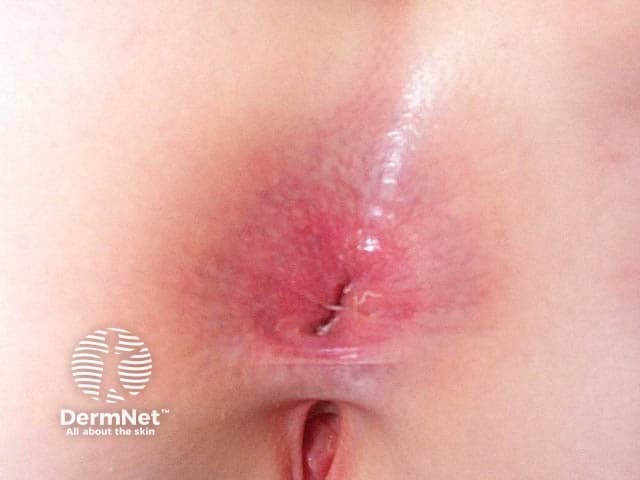Main menu
Common skin conditions

NEWS
Join DermNet PRO
Read more
Quick links
Author: Daniel Jun Yi Wong, Medical Student, University of Melbourne, Australia, 2012. DermNet Update September 2021
Introduction Demographics Causes Clinical features Complications Diagnosis Treatment Outcome
Pinworms (Enterobius vermicularis) are also called threadworms or seatworms, and the condition they cause is called enterobiasis or, the older term, oxyuriasis.
Infestation or infection with pinworms is most common amongst school-aged children, in some communities affecting up to two-thirds of children aged 5-10 years. Family members are at particular risk of acquiring pinworms.
Some studies report a male predominance.
The worldwide infestation rate is estimated to be 1 billion. It can affect all social classes, races, and countries.
Pinworms belong to the phylum Nematoda. They have a long thread-like appearance, are a white-beige colour, and round in shape (roundworm). They are visible to the naked eye - the female pinworm is 9-12 mm in length while the male is much shorter, 3-5 mm. The translucent eggs are an asymmetrical elongated oval shape visible under a microscope.
At night, the female adult pinworm emerges from the anus to deposit eggs onto the skin around the anus. It is thought to be the movement of the female worms that causes the itch. The eggs are attached to the skin with an adhesive mix. After exposure to the air, the microscopic eggs mature and are typically infectious within a few hours. They can survive for up to 2 weeks on the skin.
The main way that pinworms spread is through swallowing the eggs. When someone with pinworm scratches their perianal skin, the eggs are lodged beneath their fingernails, and can be deposited on clothing, toys, and furniture. Infested individuals ingest the eggs (auto-infection) when biting their nails, or putting fingers in their mouth.
Others can come in contact with pinworm eggs and ingest them unknowingly, although the eggs survive only a few days in the environment.
Pinworm infestation can spread during sexual intercourse.
The most common symptom caused by pinworms is itching around the anus. The itchiness tends to be worse at night when the female worms are active on the skin surface and can cause trouble sleeping.
The adult worms sometimes migrate to the vagina instead of returning to the bowel. This may result in an itchy vaginitis with a mucous or blood-stained discharge.
Severe infestations rarely result in abdominal pain, nausea, or vomiting.
However 40% of infested individuals have minimal symptoms or are asymptomatic
The adult worms can be seen with the naked eye, as thin, white, wriggling threads: look at the anus at night or at the surface of bowel motions.
The ‘sticky tape’ test involves sticking a piece of clear adhesive tape to the crease of the anus, and is best carried out at night. The tape should catch any pinworm eggs, which can be confirmed by looking at the tape under the microscope.

It is important to prevent the spread of infection by maintaining good hygiene (hand washing with soap and water, keeping fingernails short, taking a shower or bath daily), washing linen and clothes in hot water (>40C), and trying not to scratch in order to prevent contact with the pinworm eggs.
Mild infections can clear by themselves. However, pinworm infestation is usually treated with albendazole or mebendazole. A single dose has a high cure rate. A second dose two weeks later helps to prevent recurrence of the infection. After each dose bed linen should be changed and the bedroom vacuumed.
Topical treatment of the itch may be required.
Because re-infection is common, the whole family should be treated at the same time to prevent recurrence and spread of infection to others.